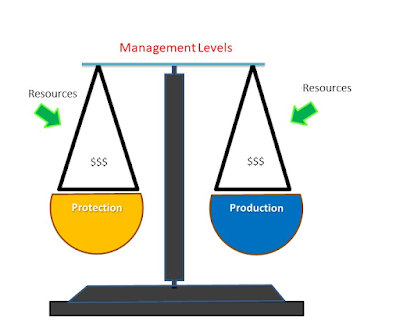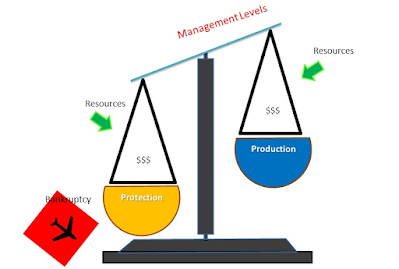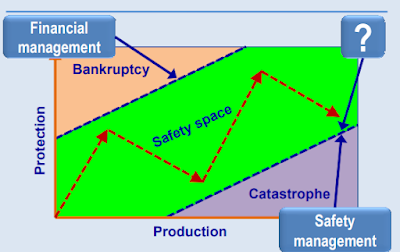Download this article in Arabic Pdf here
{getToc} $title={Table of Contents}
Airlines deliver air travel services, these services are associated with safety risks depending on the nature and dynamics of the operations, its scope, and the operating environment, etc.
Therefore, airlines need to maintain profitability to stay in business (continuity) while maintaining their competitive position by striking a balance between allocating resources to “production” and allocating resources to “protection (safety).”
Protection in airlines is carried out through the safety management system as an integrated system with other management systems, it has the same organizational level, operates in the same environment and safety culture, adopts the same language and activities, and follows common procedures for managing other business risks (operational, quality, insurance, and legal, etc.
A safety management system allows airlines to integrate safety risks into all the other risks that the airline needs to manage.
Costs associated with protection
To implement a safety management system, there are costs - money, time, and resources - related to managing safety risks such as the costs of implementing new technology, safety management and training, designing standard operating procedures, developing the documentation, internal auditing, etc.
The purpose of protection is usually to improve safety performance and not production performance. Therefore, investing in an improvement in “protection” also leads to improvement in “production quality”. In other words, reducing incidents and accidents and thus avoiding associated costs.
Costs associated with production (operating)
To deliver travel services, there are several fixed and variable costs incurred by the airline. Direct operating costs are those directly related to the operation of the aircraft such as fuel and oil, maintenance and repair, landing fees, route fees (including navigation), handling fees, crew expenses., overhead costs related to passengers, etc.
For indirect operating costs such as general administration costs, sales, administration, accounts, recruitment and human resources, property costs, etc.
The importance of allocating resources
Safety management is a core business function managed by the Safety Management System Manager, and establishes the ultimate accountability and responsibility for safety from the highest level in management of the airlines (the Accountable Manager).
Also, the Safety Management System establishes accountability and responsibility for safety for the lower management levels, and all workers along with their responsibility in achieving production goals.
Safety accountability and responsibility in the safety management system are evident at higher management, especially in decisions related to resource allocation, and thus may result in a dilemma in allocating resources between production and protection.
Dilemma of the Two Ps
Because the goal of airlines is to deliver travel service as a primary goal, providing this service in a timely and efficient manner may sometimes conflict with operational safety considerations, and this is called the management dilemma in aviation safety management literature.
The management dilemma — called the “dilemma of the two Ps”— occurs because of the competition between the objectives of allocating resources for production and allocating resources for protection (safety management).
Balanced allocation of resources to production and protection
Balancing between resource allocation to production and protection occurs when safety management is a core business function, and balancing is considered in organizational decision-making related to safety performance when deciding to expand production or improve its quality.
Therefore, we find that safety and production efficiency are closely interconnected and are not in competition. This results in a balanced allocation of resources to ensure that the airline is protected as it produces the service. Here there is no dilemma.
Allocating resources to production and ignoring protection
Airlines usually fall into a dilemma due to the imbalance in resource allocation due to the competition between production and protection. As competition develops, protection is lost because the airline still prefers to allocate resources to production (services) goals. Service-biased regulatory decision-making creates a management dilemma that, if not avoided over time, can ultimately lead to an accident.
Example
Operating passenger flights under conditions dictated not so much by operational safety considerations as by service delivery considerations. Like adhering to a schedule, the plane needs to land at a certain airport at a certain time, ignoring operational safety (adverse weather conditions, etc.).
The airlines' management believes that flight operations must be conducted under these conditions, ignoring operational safety considerations, to provide timely travel service.
Allocating resources to protection and ignoring production
Although this has been difficult to do in the history of aviation, preferring to allocate resources towards protection and ignoring production goals can lead to bankruptcy.
Safety Space
Safety space is a metaphor for the area that defines the safe boundaries for airlines to balance production/profitability while maintaining the required protection. Thus, management avoids excessive allocation of resources to production at the expense of protection because this may ultimately lead to an accident. Or management allocates excessive resources to protection until the activity becomes unprofitable, and this may lead to the risk of the airline becoming unviable (bankruptcy).
Airlines need to continually monitor and manage their safety space, for example, using financial management systems to recognize when they are very close to bankruptcy and applying the same logic and tools that safety management uses to monitor their safety performance. This allows the airline to operate profitably and safely within the safety space.
Summary
Safety management through an effective safety management system is linked to the fundamental goal of maintaining airline business continuity through risk management, regardless of the type of risk.
Safety management ensures analysis of the organization's resources and objectives and allows for a balanced and realistic allocation of resources between protection and production, supporting the overall service delivery needs of the airline.
This is why the resource allocation process is one of the most important organizational processes, and the senior management of airlines must consider achieving a balance between production and conservation goals.
More reading :
1- ICAO Doc 9859 (2.4), Safety Management Manual (SMM) of the International Civil Aviation Organization (ICAO).





